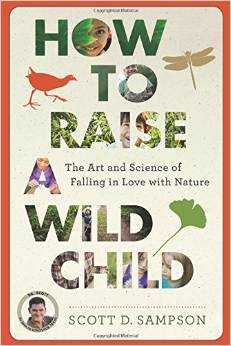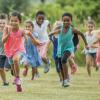 We all know nature is good for kids, but sometimes it can be hard to make the time in busy family schedules for outdoor exploration and play.
We all know nature is good for kids, but sometimes it can be hard to make the time in busy family schedules for outdoor exploration and play.
In this new book, How to Raise a Wild Child, Scott Sampson of the PBS Kids hit Dinosaur Train shares how and why to help kids fall in love with nature and why it’s critical for both the planet and ourselves.
In this Q&A Dr. Sampson shares a preview of his book, including tools for encouraging life-changing nature connection at every age. (See Sampson speak on Thursday, April 2, at Town Hall Seattle.)
**Enter a giveaway for a copy of the book and lecture tickets!
How did you get interested in science and nature as a kid?
Both my mother and father had a love of nature, and they demonstrated this passion through frequent camping trips and day-outings to natural places. Of course, the 1960s and 70s were a time when most kids had the freedom to roam. For me, this meant exploring a forest just a couple of blocks from my home on the west side of Vancouver, British Columbia. My mother in particular was a wonderful nature mentor, though I don’t think she thought of herself in this way. She was constantly fueling my curiosity for all-things-nature-and-science-related. One of those topics was dinosaurs. Whereas many kids pass through a dinosaur phase, I never managed to emerge on the other side. Some people like to say that I never really grew up!
 Tell us what the research says both on kids’ declining exposure to nature and why it’s especially critical that they get more nature exposure?
Tell us what the research says both on kids’ declining exposure to nature and why it’s especially critical that they get more nature exposure?
The average North American child currently spends seven to ten hours each day staring at screens, and mere minutes engaged in unstructured play outdoors, a dramatic transformation within the past generation. In part as a direct result of this indoor migration, rates of obesity, ADHD, heart disease, and depression among children have been skyrocketing. Numerous studies now demonstrate the critical importance of unstructured outdoor play for growing minds and bodies, making kids healthier, happier, more focused, and creative. And many other studies document the power of hands-on, place-based learning in natural settings. Put simply, kids need nature, and they aren’t getting it.
What’s a fact about kids’ connection to nature that would surprise parents?
Connecting children with nature is less about those infrequent trips to truly wild places like national parks, and more about abundant time spent in nearby nature. Frequent interactions with the natural world close to home have the greatest power to sway our emotions and help to foster deep connection. So the nearby nature found backyards, courtyards, schoolyards, and parks are going to be the ground of nature connection far more than the landscapes of Yellowstone or other distant locales.
How can we not just “expose” kids to nature but help them fall in love with nature?
The process of nature connection comes down to a trio of factors, applicable at any age and encapsulated in the acronym “EMU.” The “E” stands for experience, by which I mean firsthand encounters that engage the full suite of senses. Nature must be absorbed through our eyes, ears, nose, and pores, as well as our minds. Few of us need to be convinced that holding a slug or beholding a sky full of stars on a warm summer night differ mightily from virtual alternatives. It’s this direct experience that is so powerful in fostering emotional connections.
Next is mentoring. Being a nature mentor does not mean teaching kids to survive in the wild. It doesn’t involve being an expert on nature (though some are), or guiding every activity a child does outdoors. Instead, nature mentors ask lots of questions and offer few answers. They are co-conspirators, fellow explorers, and chasers of clues, leading from behind rather than in front. Nature mentors value nature themselves, and pass this value onto children. Most importantly, they ensure that kids get abundant, unstructured time in natural settings.
The last member of the EMU trio is understanding. Emphasis here is not on accumulating nature facts, like the names of plants and animals (though some of this happens). Far more important is giving children a sense of the grand context of things, helping them to see the deep connections through which they’re interwoven with the natural world. How does energy and matter flow through your local ecosystem? What’s the epic story of your local place, the one that encompasses earth, life, and people? Once this sort of root knowledge is instilled, even in a general sense, children can grow lasting insights and meaning. And, for nature connection to really take hold, understanding must also be of the bodily sort — the kind of knowing that influences emotions as well as the mind.
What kind of nature experiences are best for kids and families? How can they work science into the mix?
The kinds of nature experiences that are most powerful for children changes as those children grow up.
- During early childhood — say, up to five or six years of age — the most important ingredient is plenty of unstructured nature play — what psychologists often refer to as “free play.” This means kid-driven, imagination-rich activities that foster wonder. Natural and easily collected “loose parts” like sticks, rocks, leaves, and acorns make great toys at this stage, because they can be used for an infinite variety of activities. Wildness is another important factor, though it’s important to remember that our sense of wildness changes as we mature. For young children, a backyard with a few bushes and rocks can be plenty wild.
- During middle childhood, around six to eleven years of age, the geography of nature exploration needs to expand. Wildness at this phase can mean a walk up an urban creek or exploring the forest in a local park. Meanwhile, longings migrate toward increased autonomy, risk, and competence. Nature mentors can help by giving kids more space and responsibility—for example, sending them off on collecting expeditions, whether for berries, lizards, or photographs. When children return, grown-ups can ask questions and gently pull out stories. For nature connection to persist, it’s important to continue to limit screen time, get kids outdoors, and foster wonder whenever possible.
- Finally, during adolescence, the geographic range of nature adventures expands again, preferably to include true wilderness once in awhile. Thanks to changes in brain growth, teens seek plenty of time with their peers in risky situations. Nature mentors can find healthy outlets for this compulsion by providing opportunities for adolescents to take calculated risks with one another in natural settings (appropriately supervised of course). By this age it’s best if children have discovered a nature activity that they’re passionate about, one that requires increased competency over time—for example, skiing, backpacking, birding, or gardening. Service learning, although powerful at any age, offers another powerful pathway for teens to take on responsibility, engage in challenging activities with peers, and fine-tune their moral compass.
I was surprised to see you recommending using technology as a way of exciting kids about nature experiences. Tell us about that.
I am by no means arguing that kids need to unplug entirely and return to some long-gone days when all they did in their free time is play outside. Digital technologies are here to stay. The key here is finding a balance between technology and nature. Sometimes this means turning the screens off and enjoying nature in all of its multisensory splendor. But other times, digital cameras can be used to engage with nature by taking photos. And a plethora of downloadable apps can be used to help identify rocks, plants, animals, constellations, and other natural phenomena. If screentime can help foster greentime, then I’m all for it!
What are simple ways parents can encourage environmental responsibility as well as nature connection?
These days, we often tell kids to stay on the trail, to leave “only footprints.” Counterintuitively, this approach, aimed at protecting both children and nature, make work against both. For a deep, lasting bond with nature to take hold, children need to engage bodily with nature. They need the freedom climb trees, throw stones, pick flowers. Does this mean we encourage them to run wreak havoc? No, of course not. But just as we tend to develop strong passions for people we truly interact with, so too we need to meet nature on her own terms.











